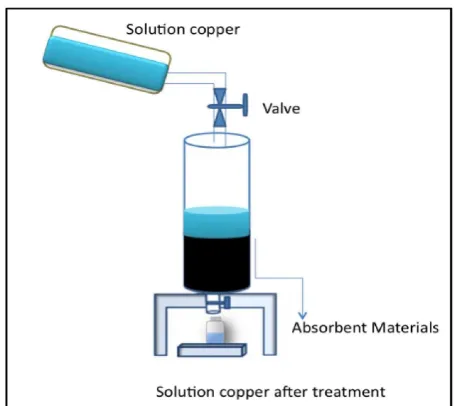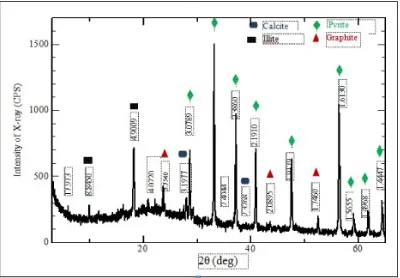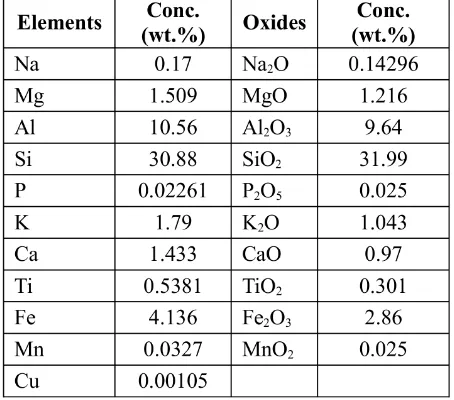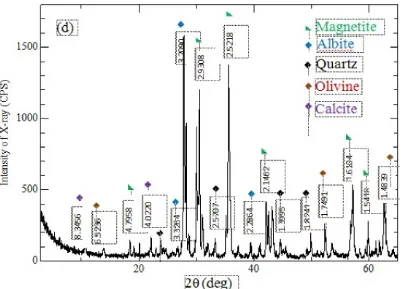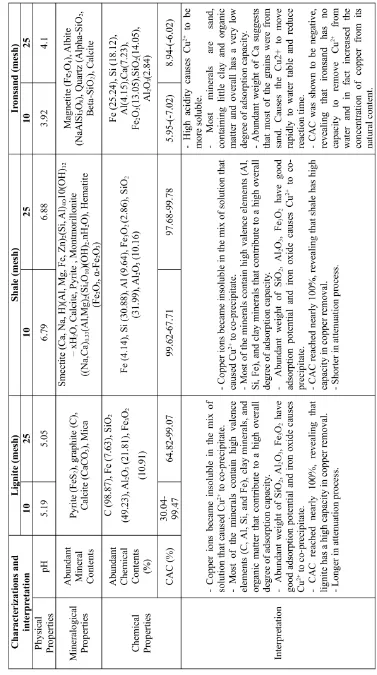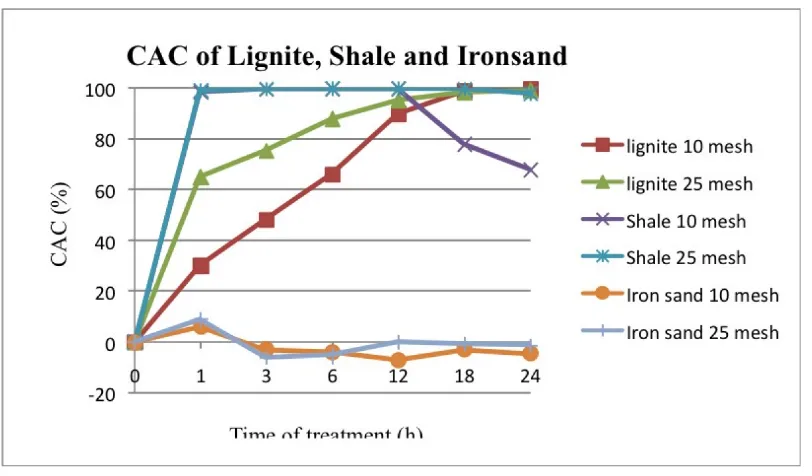REMOVAL OF COPPER FROM WATER USING
COLUMNS EXPERIMENT OF LIGNITE, SHALE,
AND IRONSAND
Ty Boreborey∗, Wahyu Wilopo, and Doni Prakasa Eka Putra
Department of Geological Engineering, Gadjah Mada University, Yogyakarta, Indonesia
Abstract
Experimental studies using column testing of lig-nite, shale, and ironsand in copper solution were carried out to determine the adsorption capacity of lignite, shale, and ironsand in remediation of water contaminated with copper. Lignite, shale, and iron-sand were analyzed using XRD, SEM/EDX, and XRF. The treatment process by column adsorption was carried out over a period of 24 hours at a sta-ble velocity of 0.005ml/s. After treatment, the re-maining copper in the solution was recorded, thus allowing the adsorption capacity of lignite, shale, and ironsand to be calculated. The results revealed that when the solution was treated by lignite and shale there was a good degree of copper removal, while the ironsand had very poor degree of copper removal. The best material for copper removal was lignite with 25-mesh grain size. Pyrite, graphite, calcite, and illite were found in lignite and smec-tite, calcite, pyrite, hemasmec-tite, and illite were found in shale. These materials were also shown to contain an abundance of high-valence elements in Al2O3,
SiO2, and Fe3O4which contributes to additional
ad-sorption capacity. CAC values for lignite and shale reached nearly to 100%, suggesting that lignite and shale have a high adsorption capacity. In contrast, ironsand, which has mostly sand minerals with lit-tle clay and organic content, caused the pollutant to move rapidly to the water table, reducing the adsorp-tion potential. CAC values treated by ironsand were
∗Corresponding author: T. BOREBOREY, Department of Geological Engineering, Faculty of Engineering, Gadjah Mada University, Jl. Grafika 2 Yogyakarta, 55281, Indone-sia. E-mail: [email protected]
shown to be negative which showed an increasing of Cu2+
in natural ironsand into solution.
Keywords: Copper, ironsand, shale, lignite, col-umn experiment
1 Introduction
Introduction Water can be contaminated by heavy metals which include copper derived from various sources. Heavy metal contamina-tion of groundwater is a widespread problem in Indonesia. The primary sources of copper in in-dustrial wastewaters are metal-process pickling baths and plating baths. In general, copper is soluble and bio available at low pH and there-fore toxicity problems are likely to be more se-vere in acid environments (Allowey and Ayres, 1993). Many techniques have been proposed for removing contaminants from water, although most of them suffer from particular technical and economic limitations (Batcheloret al, 2002). Column and bach tests have been carried out on groundwater with known contamination levels of metals in laboratory conditions using vari-able concentrations of contaminants and reac-tive materials (Freetheyet al, 2002).
REMOVAL OF COPPER FROM WATER USING LIGNITE, SHALE, AND IRONSAND
Figure 1: Schematic diagram of the experimen-tal set up for the adsorption process.
lignite, shale and ironsand in removing copper ions from the water.
2 Materials and Methods
The goal of laboratory work was to determine the characteristics of the adsorption materials in terms of physical, mineralogical, and chem-ical properties. The lignite sample was taken from Samigaluh Kulon Progo, the shale from Bogor, and the ironsand from Glagah beach. These three materials were first characterized by means of X-ray diffraction (XRD) investi-gation, scanning electron microscope or en-ergy dispersive X-ray (SEM/EDX), X-ray Fluo-rescence (XRF) and physical property analysis. Secondly, the column adsorption experiments were conducted over a period of 24 hours. A to-tal of 6 columns were used with 6 cm diameters and heights of 30cm each. Two different sizes of grains were chosen for each sample, which were coarse 10-mesh and fine 25-mesh and pre-pared in 300g samples for each material. The 6 samples were then put into different columns as the reactive media. The solution of copper was allowed to flow vertically through the column at a constant velocity of 0.005ml/s (Figure 1).
The experiment on groundwater treatment using lignite, shale, and ironsand with the
method of column adsorption was done by putting the 300g of ironsand, lignite and shale samples of 10-mesh and 25-mesh each into PVC columns, then flowing vertically the solution of copper with the concentrations of 7ppm into the columns. The amount of the dry ironsand, lig-nite and shale grains requires only one exper-iment each with the two different grain sizes done simultaneously over 24 hours, which is considered enough to achieve equilibrium con-ditions at constant temperature (25◦C). This is
to keep the materials in suspension and allow the ion exchange reaction between the cations of ironsand, lignite and shale with the Cu2+
in solution. After the experiment, all the solutions were analyzed by the AAS (atomic absorption spectrometer) method to identify the remaining copper. The formula of Vegaet al (2005) to cal-culate the cation adsorption capacity (CAC) or the concentrations of heavy metals adsorbed by the ironsand, lignite and shale granular is ex-pressed below:
CAC= Ci−Cf Ci or
Cads =Ci−Cf (1)
Where:
CAC: cation adsorption capacity (percentage adsorption)
Cads: concentration of heavy metal adsorbed
by iron sand, lignite, and shale
Ci: initial concentration of heavy metal (be-fore the experiment)
Cf: final concentration of heavy metal (after the experiment).
Figure 1: Schematic diagram of the experi-mental set up for the adsorption process
3 Results and Discussion
3.1 Lignite
Figure 2: X-ray diffractogram of the lignite sample.
Table 1: The result of specific major oxides and trace metals for this research from XRF analysis of lignite.
mineral also contribute to an overall high ad-sorption capacity.
Using the weights of oxides present in the lig-nite sample, it may be interpreted that the pres-ence of Fe2O3rose to 10.91, meaning some
cop-per was co-precipitated in this oxide and some
was absorbed by Al2O3 and SiO2 which also
have abundant weights in lignite.
3.2 Shale
XRD analysis of the shale samples display the major contents of smectite and calcite shown at the peaks of the diffractogram (Figure 3). More-over, illite, hematite, and pyrite are also present in the content.
The XRF analysis showed the specific major oxides and trace metals of shale which included SiO2, Al2O3, Na2O, CaO, K2O, TiO2, Cd, Cu, Fe,
Pb, Zn, Mn, and Ag (Table 2). We can see Fe2O3,
SiO2, and Al2O3are much more abundant than
other chemicals. This means the shale, like lig-nite, is suitable as an ion adsorption material.
3.3 Ironsand
REMOVAL OF COPPER FROM WATER USING LIGNITE, SHALE, AND IRONSAND
Figure 3: X-ray diffractogram of the shale.
Table 2: The result of specific major oxides and trace metals from the XRF analysis of shale.
Table 3: The result of specific major oxides and trace metals from XRF analysis of ironsand.
theory that it would have a low adsorption ca-pacity. The XRF analysis shows the major ele-ment oxides in the sample (Table 3).
3.4 Solution Copper Treatment
Figure 4: X-ray diffractogram of the ironsand.
size, crystal structure and chemical composi-tion analysis. Experimental data from copper solutions from XRD and XRF analysis show that Cu2+
was removed by shale and lignite more than ironsand. The negative values from iron-sand suggest that it is not suitable for the treat-ment copper whatsoever.
According to Figure 5, the CAC of shale of grain size 25-mesh is nearly 100% from the be-ginning of treatment at the duration of 20 hours at which point CAC began to drop. The CAC of shale with grain size 10-mesh decreased at the duration 18-24 hours. Lignite however strongly absorbed Cu2+
over the entire period of treat-ment with no apparent decreasing of CAC even at the duration of 24 hours. Ironsand displayed negative values for CAC, and it can thus be said that it has no capacity in copper removal and may even more cause the content of Cu2+
in so-lution to increase.
4 Conclusion
The absorption capacities of lignite, shale and ironsand have been characterized. For lignite, XRD showed that clay minerals and the organic matter were abundant and XRF showed abun-dant weights for the elements and oxides C, Al, Si, Fe, Al2O3, SiO2, and Fe3O4. In
compar-ison, shale contained no organic content, but more clay minerals were detected. XRF anal-yses showed abundant weight for the elements and oxides Al, Si, Fe, Al2O3, and SiO2. These
parameters play an important role in the degree of overall adsorption. In contrast with lignite and shale, ironsand analysis showed abundant magnetite, olivine, quartz, and calcite and a lack of clay and organic matter. This is thought to cause ironsand to have a low absorption ca-pacity and cause the pollutant move rapidly to the water table, reducing the effectiveness of the adsorption process.
When the copper solution was treated by lignite, Cu2+
became insoluble in the solution due to pH increasing from acidity to neutral and Cu2+
REMOVAL OF COPPER FROM WATER USING LIGNITE, SHALE, AND IRONSAND
T
ab
le
4:
S
u
m
m
ar
y
o
f
d
is
cu
ss
io
n
o
n
ch
ar
ac
te
ri
za
ti
o
n
o
f
li
g
n
it
e,
sh
al
e,
an
d
ir
o
n
sa
n
d
Figure 5: Copper adsorbed by lignite, shale and ironsand.
characteristic study, lignite has a high adsorp-tion capacity and this was further suggested by the column experiment in which CAC treated by lignite reached to 99.47%. When the cop-per solution was treated by shale, the increas-ing of pH to neutral caused Cu2+
to be co-precipitated. From AAS analyses, CAC reached to nearly 100% and agreeing with the character-istic studies of shale, it suggested that it has a high degree in adsorption capacity. When the copper solution was treated by ironsand, high acidity caused Cu2+
to be more soluble. Iron-sand’s characteristic studies suggested that it would have a very low ability in adsorption capacity, and the negative value of CAC sug-gested clearly that ironsand has no ability in adsorption capacity to remove Cu2+
from the solution, and increases the Cu2+
concentration from the natural conditions. Through our ex-perimental studies, it has been suggested that the best material for copper removal in contam-inated water is lignite with 25-mesh grain size.
Acknowledgment
The writer would like thank to the Indone-sian Government, who have encouraged and
supported the budget for this Master’s The-sis and publication. Special acknowledgement is made to friends and colleagues, who have helped, contributed data, given valuable dis-cussion and suggestions during the preparation of this publication.
References
Alloway, B.J., and Ayres D.C. (1993) Chemical Prin-ciple of Environmental Pollution. By the Alden Press, Oxford ISBN 0-751400130, p. 116–140. Batchelor, B., Hapka, M., Igwe, G., Jensen, R.,
McDe-vitt, M., Schultz, D., and Whang, J. (2002) Method
for Remediating Contaminated Soils. United
States Patent No. 6,492,572 B2. p. 17–23.
Freethey, G.W., Naftz, D.L., Rowland, R.C. and Davis, J.A. (2002) Deep Aquifer Remediation Tools: theory design and performance monitor-ing. Elsevier, San Diego, 539p.
